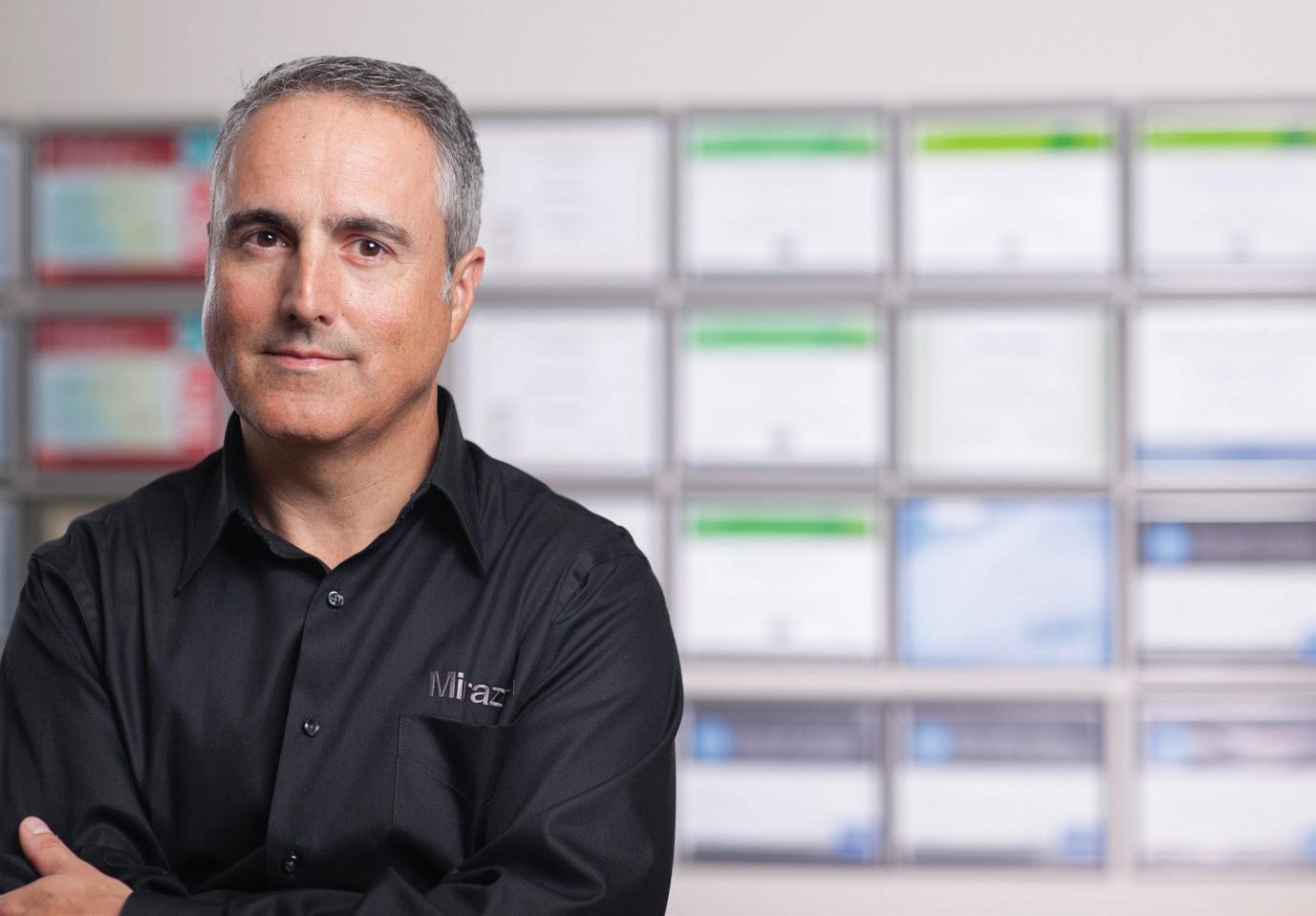
11 minute read
Mirazon: Agility Equals Profitability
by ⌘ ⇧ ⌥
CRAIG STEIN PARTNER, MIRAZON


Fast, fl exible, and affordable fi ber services unlocked myriad opportunities for IT company Mirazon. Agility Equals Profi tability
THE CHALLENGE: Mirazon, a Louisville, Kentucky–based IT consulting fi rm, builds and maintains optimized IT solutions for a wide range of national and international clients. Since 2000, the company has prided itself on creating ahead-of-the-curve solutions for everything from virtualization, storage, and backup to training and CIO outsourcing. But staying ahead in the IT business now requires more agility and fl exibility than ever, according to Craig Stein, partner and solutions architect. “Managing IT used to involve maintaining a few products,” he says. “Now, from Microsoft licensing to antivirus protection, there are so many moving parts. Plus, with the cloud and virtualization, it’s easy to spin up a new platform as a service without even involving the IT department.”
In order to keep on top of its customers’ growing needs, Mirazon needs maximum agility and bandwidth for its own technology. The asymmetrical “best effort” Internet service it had been using wasn’t up to the task.
THE SOLUTION: In 2012, Mirazon turned to Time Warner Cable Business Class (TWCBC) for its fast, affordable, and reliable fi ber solutions. “They are a key blade in our Swiss army knife of solutions,” Stein says. With fi berbased Dedicated Internet Access (DIA), Mirazon could now take advantage of its growing opportunity to offer remote security and managed solutions to a diverse range of customers. Mirazon especially appreciates the value of fi ber’s symmetrical bandwidth. “Most businesses download more content than they send up,” Stein explains. “But with offsite backup or supporting branch offi ces, fast upload speeds also become critical.” Because of its fi ber-based DIA offering speeds up to 20 Mbps, Mirazon has the bandwidth to handle customer collaboration, meetings, video conferencing, and instant messaging through the Microsoft Lync unifi ed communications suite. “The connection is low-latency, so voice packets don’t get scrambled or delayed,” Stein says. “Time Warner Cable Business Class technology is very fast and affordable. But we’ve also found that it’s an extremely reliable service.”
THE RESULT: Thanks to fi ber service from TWCBC, Mirazon has been able to better serve existing customers, acquire new customers, and maintain an edge over other IT consultancies. White_Rev FIELD REPORT
4cp_Rev
Through fi ber connectivity, Mirazon can fi x customer service problems remotely in minutes. Fiber also enables Mirazon to provide enhanced backup that includes multiple copies of important fi les, supports two different media types and stores copies at a second network location.
The affordability of fi ber has enabled Mirazon to work with an exceptionally wide range of customers, from companies with two computers to those with multibillion-dollar defense contracts. “Where solutions used to cost hundreds of thousands of dollars, we can now leverage fi ber solutions that are affordable for companies of all sizes," Stein says. Pantone 661 Pantone 1375 100 cyan 72 magenta 6 black 40 magenta 95 yellow
Overall, Mirazon now has the capacity to meet customer needs with leading-edge solutions. “Businesses are trading hosting and private infrastructure for cloud offerings like Microsoft Offi ce 365 and Amazon Web Services,” Stein says. “This drives the need for faster, more reliable connections, and that’s what Time Warner Cable Business Class provides.”
SHARE YOUR STORY! How did you partner with TWCBC to SOLVE your technology issues? Tell us about it for a chance to be featured in an upcoming issue of SOLVE. Visit business.twc.com/nomination to share your story.
GET YOUR TEAM
Leading the Multigenerational Workforce IN STEP





Understand the generational culture clash, and get the best from your entire workforce.




BY BRAD SZOLLOSE H ow many of you are tired of hearing about Millennials? Go ahead and raise your hand. Even Millennials are tired of hearing about Millennials.
And yet this newest workplace generation—whether called Millennials, Generation Y, or Digital Natives—is, and should be, discussed, because its members are causing disruption. Here’s why: they do not obey or live by any of the rules that made previous generations successful.
In fact, their behavior is so radically different when it comes to career and workplace expectations that it’s affecting communication, productivity, advancement, and retention in all organizations. Since many bosses are not ready to retire




anytime soon, and Millennials are moving into management positions, a traffi c jam has begun.
As a leader you need to understand this generational phenomenon. To propel your business forward, you need insight into the behavioral dynamics of each generation in order to create a positive corporate culture and prepare the next generation for leadership.
Step one is to understand what, as a general rule, motivates each generation.
WHAT BOOMERS EXPECT When defi ning generational categories, we’ll keep it simple. Many divide the generations into Traditionalists, Gen X, and so on, but the real workplace differences are between Millennials and everyone else. As a rule, anyone born before 1977 (Baby Boomers, Gen X) was taught a traditional path to success. Listen to the teacher, study hard, pass the test, then you move forward. Age + Time + Experience = Status and Salary. Getting ahead took time and effort. Boomers know their place in an organization, never expecting to chat with the CEO until they have earned the right to do so, either through title, experience, or age. And when a Boomer has a much younger boss, he or she can feel like a failure. For anyone born after 1977 (Millennials)—age is not a criterion for advancement. Skill set is. So when a 25-year-old joins a company, he or she sees no issue with entering at the same level as the Boomer with years of hard-earned experience. What causes this disconnect in expectations?
INSIDE THE MILLENNIAL MINDSET Millennials grew up in a time of child-centric parenting, in which they were routinely consulted about their wishes and included in adult discussions. This approach spread to schools and sports, and the effect was a fl attening of hierarchy in Millennials’ lives.
As a result, they see their older workplace superiors not as authority fi gures, but as peers—approachable and easily available to hang out with, learn from, and run new ideas past. This lack of intimidation is not a lack of respect. Millennials simply don’t recognize traditional boundaries.
SPANNING THE DIGITAL DIVIDE

Employees approach workplace technology very differently, based not only on age but on work experience, according to Brett Belding, senior manager of Cisco IT mobility services. “Diversity is broader than most people defi ne it,” he says. “It’s important to address everyone’s needs, from the most technically acute to those who don’t ‘speak geek.’” Here’s how his team’s approach to IT support is evolving: Moving toward self-support. As little as seven years ago, all technical help at Cisco was provided by an IT help desk, accessed via a phone number prominently displayed throughout the company. However, the IT team became aware that more tech-savvy employees had begun to create their own wikis or blogs to share information about technical issues. Belding’s team not only adopted some of the wikis, they expanded the idea so that now the default method of getting help with a technical issue is to go to an internal website. (The help desk is still available as a backup.) The team uses focus groups to fi ne-tune the help language. The goal is to make the IT support information accessible even for employees whose tech expectations had traditionally been “I make a call, and someone fi xes this for me.”
Self-support is cost-effective and scalable. It’s also in line with Belding’s goal of “consumerizing” IT strategy. “If you want to create a Facebook account, sign up for Gmail, or download an app, you don’t call somebody—you sign up with a few clicks,” he says. “For Millennials, that is the mindset. You don’t pick up the phone.” Allowing choice. “The assumption with digital natives is that they will show up with the technology they want to use, because technology is critical to their lives,” Belding says. “And if you want to hire the best employees, you need to allow them to work how they want.”
Accordingly, Cisco has loosened up its requirements for work technology. The company used to stipulate that all its employees had to use Windows; now they can use a range of operating systems and products. Cisco has also embraced "bring your own device" (BYOD), allowing employees to use the personal device of their choice.
“The workforce is undergoing a huge shift in attitude,” Belding says. “So we provide choice, then give employees a set of applications that can make them really productive, no matter what device they’re on.”
—Lee Lusardi Connor
MILLENNIALS IN THE WORKFORCE
34% 2014

Second, technology changes behavior. Millennials were raised to adapt to rapid change. With hundreds of software upgrades, the Internet, and interactive toys, Millennials learned to manipulate digital information before they could read and write, and in some cases, before they could speak. Because of this, nothing is ever “fi nished.” Constant change is normal.
Millennials were also immersed in a new entertainment platform: video games. And it shaped them. How do you learn in a complex video game? You do not read a manual; you participate and learn the rules intuitively. Leadership is rotational and you use your team players and their individual skill sets as needed. After mastering one level, you discard what you’ve learned, because the rules change at the next level.
Boomers were taught that if you screw up, your career is over. Meanwhile, Millennials were trained that making mistakes is the only way to learn.

FOCUS ON THE WORK Both Boomers and Millennials have crucial skills, experiences, and insights for your business. Moreover, Millennials have something to teach management about new technology, a new workforce, and a new customer. We are in a marketplace in which technology allows smaller companies to compete with big brands; in which old jobs are disappearing and new ones are being created.
To keep your company both relevant and harmonious, create an environment where all generations can thrive. Here are a few ways to do that. • Groom for leadership. Don’t simply hope that new hires will fi gure out the way your company does things; show them. Develop an internal apprenticeship program to give them
46% 2020

SOURCE: UNC KENAN-FLAGLER BUSINESS SCHOOL, “MAXIMIZING MILLENNIALS IN THE WORKPLACE,” 2012
the proper training in your company’s methodologies. This is where Boomer experience pays off in dividends. Become a valued mentor instead of a boss. • Flatten your hierarchy. If you are clinging to traditional management styles, then you are waiting for decisions to go through the chain of command, and that creates bottlenecks. By fl attening your organization, training people to make decisions without you, and giving them the tools they need, you create an organization that moves faster. And that makes all generations more productive. • Consider a Results-Only Work Environment (ROWE). ROWE is a fl exible management strategy, created by Cali Ressler and Jody Thompson. Because it focuses on results, it allows individuals to work in the way that suits them best. For example, Boomers tend to see work as a “place you go to”—the offi ce—while Millennials see it as a “thing you do,” to be done anywhere, at any time, even in a coffee shop. A ROWE approach can accommodate all styles. Consider each project a mission, with deadlines and tactics, and yourself a mission leader whose job is more support than command. Let each team member set his or her own goals for the week, do all you can to support those goals, and stay in touch with weekly check-ins. In this way, talented individuals can rise to the surface and be given greater and greater responsibilities. And this keeps the best people in any generation engaged and excited by their work.
Business consultant Brad Szollose helps smart companies understand how technology has transformed a new generation and how that impacts businesses. He is the author of the bestselling Liquid Leadership: From Woodstock to Wikipedia.

